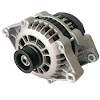Turbines
1. Based on action of water on moving blades
a) Impulse turbines. (Peltton wheel turbines, Turgo)
b) Reaction turbines. (Francis, Kaplan, propeller)
2. Based on availability of head of water
a) High head turbines (Pelton wheel)
b) Medium head turbines (Francis wheel)
c) Low head turbines. (Kaplan wheel)
Impulse Turbines:
In impulse turbine water coming out of the nozzle at the end of penstock is made to strike a series of buckets fitted on the periphery of a wheel or runner. Pressure energy of water is converted entirely in to kinetic energy. The pressure at the inlet to the runner and discharge is same and is atmospheric throughout.
The impulse turbines are suitable for water moving with high velocity and for high heads. The majority impulse turbines are horizontal shaft turbines.
Reaction Turbine:
In this type of turbine the water will enters all round the periphery of runner and the runner will be fully submerged in the water flow. Water acting on wheel is under pressure which is greater then atmospheric pressure.
If the turbine is placed below the tail race then it is very difficult for its accessibility. Hence it must be placed above the tail race.
In this type, water has both pressure energy and kinetic energy and it will forces on the rotating parts of the turbine. Casing is very necessary because the pressure at the inlet is more than at the outlet and also it provides a predetermined path for water so that it also avoids the splashing.
Shows the different views and parts of a reaction turbine.
Reaction turbines may be of horizontal shaft type or vertical shaft type turbine. These are mainly used for low and medium heads. Reaction turbines includes Kaplan, Francis and propeller turbines.
Main function of turbine is its converts steam energy into mechanical energy.










0 Comments